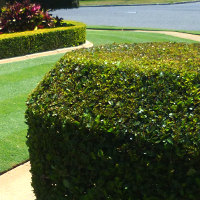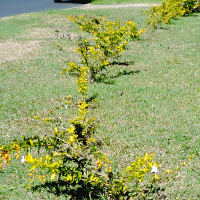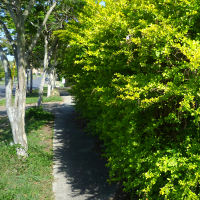







|
Information about plants & gardens for Brisbane & Qld |
|
|||
| |||
Hedges in their various forms have many advantages for the home gardener. They can be used to create an inexpensive privacy screen or boundary division (especially if you buy cheap plants or propagate your own) and are more attractive than most walls and fences. They also reflect less heat and glare than many hard surfaces.
On the downside, you may have to wait a considerable time for the hedge to grow enough to provide the desired screening. A hedge also takes up more space than a typical fence. In some cases In these days, the water needed to maintain a healthy hedge has to be a consideration in addition to the maintenance required.
A screen of vegetation might seem like a good way to reduce traffic pollution from the road reaching your home, but could it really work? A study in the United Kingdom has shown that "tredges" (trees managed as head-high hedges) lowered the amount of particulates reaching playgrounds. However, the species composition did make a difference to their effectiveness. Of the three tredge types compared in this study, western red cedar (Thuja plicata) performed best. The fine, roughly textured foliage of this conifer was good at capturing particulates. On the other hand, the smooth, waxy leaves of ivy can block polluted air somewhat, but aren't very good at capturing particulates. While research into species suitable for Australian climates is obviously necessary, it does appear that the right vegetation could make a meaningful difference in urban areas. Source: New evidence shows planting around school playgrounds protects children from air pollution (August 2022)
Crimestoppers in the United Kingdom are warning homeowners that hedge height can affect the risk of burglaries. They're recommending that front hedges be no more than 1m high and that rear hedges be 1.8m high or higher. A poll of UK households commissioned by John Lewis Home Insurance indicated a lack of awareness about this issue and what height hedges should be to improve security. "Those surveyed said they keep their front hedge high to prevent people ... seeing in but we know that what matters most to criminals is not being seen," said Mick Duthie from Crimestoppers. "A high front hedge gives them cover while they’re in a property or garden, and a low rear hedge gives them easy access to escape out the back." Source: Warning high hedges increase burglary risk (July 2022)
A wide range of species can be trained as hedges, but here's a selection including some of the most popular types of plants used in Qld. Links go to a dedicated page on this website.
The hedges requiring most work are "Formal" hedges are the tightly-clipped, geometric blocks of foliage with which most of us are familiar with from pictures of great gardens of the northern hemisphere. They can vary in scale from great walls of foliage down to decorative garden edges and knot gardens (with appropriate choice of species, of course).
Formal hedges aren't seen very much in Qld these days due to the work needed to keep them tidy, especially as the climate encourages vigorous growth. Furthermore, the number of species suitable for hot climates is somewhat limited. The conifers that are very popular in cold climates for formal hedging (yew, cupressus etc) are not suitable for tropical and subtropical climates. Small-leaved privet, which was once popular for formal hedges, is now considered a weed in Queensland.
Naturally compact species/cultivars will be better suited to hedging than those with a loose growth habit. Uusually, woody shrubs with small closely spaced leaves that come back thickly after pruning make good hedging subjects.
Many flowering species can be clipped regularly as a formal hedge, but at the expense of flowers. If you want flowers, a semi formal or informal hedge may be a better option (see below).
Many Australian natives can also be used. Once clipped and trained into a hedge, the effect will be essentially the same as exotic species.
of the natives lily pillies have proven most popular for formal hedging, particularly tight-foliaged cultivars such as Lillipilly 'Tiny Trev'. Westringia has also been used for smaller hedges. No doubt experimentation with native species in the future will reveal other hedge-worthy species.
Generally better suited to the Qld climate is the semi-formal hedge. This is still kept in shape by cutting, but with a softer, more naturalistic shape the demands of regular pruning are less onerous. While species with with small, closely spaced leaves are essential for good formal hedges, plants with a looser habit can be adapted to a semi-formal hedge e.g. Acalypha, Murraya, Hibiscus, Plumbago and others.
The semi-formal hedge or informal hedge is also more suitable for a flowering hedge, as you can wait long enough between prunings to allow allow for the development of flowers. Nevertheless, some knowledge of the flowering habits of the species concerned with help the gardener time prunings if flowers are desired (note that flower buds may be formed some considerable time in advance of the flowers appearing).
Whatever species is employed, regular pruning from the early stages will encourage the bushiness that is essential to an attractive hedge, and many species not typically thought of as hedging plants may be adapted to this form of cultivation. Bougainvillea, for example, can be formed into a hedge with rigorous pruning, although flowers may be sacrificed. Obviously, some cultivars may be more amenable to this treament than others.
In the USA, chemical plant growth regulators (PGRs) are being used to slow down the growth of hedges, reducing the cost of labour-intensive trumming (Ref: Is it Really Possible to Stop Plants from Growing?, Pinecrest Garden Guy blog, Miami).
The most informal forms of hedges are formed from shrubs are left to grow close to their natural shape, although occasional pruning will nevertheless help encourage bushiness and keep them from taking up too much space. Choice of varieties with naturally dense, upright growth will obviously be an advantage. As gardens become smaller and homeowners more time-poor, we can expect to see more breeding and selection for such charactertics in new hedging plant varieties.
Screens can also be created from plants such as clumping bamboos, clumping palms (e.g. Golden Cane palms) and assorted shrubs and small trees. The view might not be totally blocked by the less dense types of plants, but it will be enough to at least "camoflauge" the view and provide a distraction. While choosing plants with a naturally with an upright habit will help save space, informal hedges and screens tend to take up more space than regularly pruned formal hedges.
Vines and scramblers trained on a suitable support may be an alternative approach. You're likely to get faster screening and save horizontal space. A downside is that if you don't already have a fence suitable for growing a vine on, you're going to have to install something. Another problem is that narrow spaces between houses, where space is most likely to be a limitation, may have insufficient light for a vine (or a hedge, for that matter), to retain foliage right to the ground. The amount of soil to retail an adequate root sytem might also be limited in these situations. If you start with an attractive trellis, you might be less concerned if plant coverage is incomplete, and you should get at least some camoflauge ofthe view if not total blockage. See Climbers for more on such plants.
Topiary is the sculpting of plants into geometrical shapes like balls or cones or spirals. Some topiarists shape shrubs into animal forms or other fantastic shapes. The approach is similar to that of formal hedging, and indeed may be incorporated into hedging schemes, although the creation and maintenance requires special skill and extra dedication.








|
© Calyx Horticultural Services ABN 38 518 961 623
|